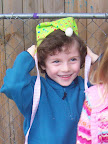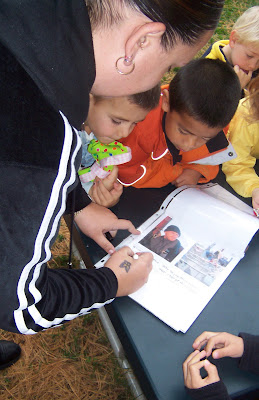Exploring form and function with hats: books about firefighters
By Peggy Ashbrook
Posted on 2010-02-04
 In the February 2010 Early Years column (Science and Children) I wrote about exploring form and function using hats, and testing them for how water flows off of them. Children might think, “Of course a firefighter’s hat works well to keep dripping water off their face and head! It’s made to do that!” And what about how well a clown hat performs its function…” Of course it makes people laugh, that’s why clowns wear those silly hats.”
In the February 2010 Early Years column (Science and Children) I wrote about exploring form and function using hats, and testing them for how water flows off of them. Children might think, “Of course a firefighter’s hat works well to keep dripping water off their face and head! It’s made to do that!” And what about how well a clown hat performs its function…” Of course it makes people laugh, that’s why clowns wear those silly hats.”
The hats work well to do the needed jobs, and because they succeed, people use them again and again. I hope that this line of thinking will help children understand that, of course a polar bear has white fur because it needs to hide almost in plain sight when it goes hunting, or that of course a duck’s foot is webbed because it needs to move easily through water. Animals that are colored to match their environment, like polar bears, are harder for other animals to see, so the bears can catch more animals to eat, and, avoid being caught by another animal. They catch more food, and live longer and have more babies survive, each generation. With feet that work well to move them through water, ducks can more easily get food and keep from being eaten. They also catch more food, and live longer and have more babies survive, each generation benefiting from the successful foot structure.
The Helper Hats: Will it protect me from water? activity will not teach children about evolution but after doing the activity they do see a connection between the form of a hat, which could represent an animal’s body, and how it functions for survival. Reading state and National Science Education Standards for the grades above preschool (the level I teach) helps me lay the ground work for the concepts that my students will encounter later on.

With every science activity, teachers incorporate literacy and language teaching—reading aloud, writing to describe an observation, discussing what we did, and learning new words such as “chrysalis”, “adaptation”, “magnetism”, “floating”, and “reflection”—and math skills such as counting, using a tally chart, and measuring.
Here a teacher records the children’s observations about a sailor “watch cap”–what they know and what it feels like when they tried it on.
Books to use with the February 2010 Early Years column activity, Helper Hats: Will it protect me from water? include the old favorite, Caps for Sale by Esphyr Slobodkina (1940), available in many formats, English and Spanish.
Your students may also enjoy:
Firefighters A to Z by Chris L. Demarest (McElderry Books, 2003). This book has been a favorite of one of my students for several years. The alphabet format includes firefighting vocabulary while informing readers about the work of firefighters.
Hats Hats Hats (Around the World Series) by Ann Morris, photographs by Ken Heyman (HarperCollins, 1993). Reading the book may open a discussion on what kinds of hats do people wear in other places and why do they wear those hats.
The Wind Blew by Pat Hutchins (Simon and Schuster, 1974). Ask your children, “Would the wind be able to blow your hat? Why or why not?”
Zoe’s Hats: A book of colors and patterns by Sharon Lane Holm (Boyds Mills Press, 2009). After seeing Zoe try on different hats (including some unexpected ones), readers can name their favorite at the end on a page showing all of the hats.
 Get the lesson plan for the Helper Hats activity in the journal Science and Children by joining NSTA. I’m lucky to teach some of my students for three years, from two years old to five years old, so I have seen them develop science process skills and learn information about the natural world over several years. Each time we do an activity again they investigate a little longer and gain new insights. I do too.
Get the lesson plan for the Helper Hats activity in the journal Science and Children by joining NSTA. I’m lucky to teach some of my students for three years, from two years old to five years old, so I have seen them develop science process skills and learn information about the natural world over several years. Each time we do an activity again they investigate a little longer and gain new insights. I do too.
Peggy
Disclaimer: The views expressed in this blog post are those of the author(s) and do not necessarily reflect the official position of the National Science Teaching Association (NSTA).

